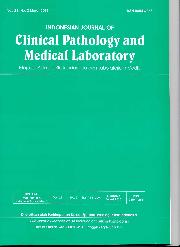Indonesian Journal of Clinical Pathology and Medical Laboratory
ISSN 0854-4263
Vol. 21 / No. 2 / Published : 2015-03
Order : 15, and page :183 - 186
Related with : Scholar Yahoo! Bing
Original Article :
D-dimer plasma levels in ishemic stroke
Author :
- Yessi Mayke*1
- Adi Koesoema Aman*2
- Y. Anwar*3
- Departemen Patologi Klinik FK USU/RSUP H. Adam Malik Medan.
- Departemen Patologi Klinik Medan FK USU/RSUP H. Adam Malik Medan
- Departemen Ilmu Penyakit Syaraf FK USU/RSUP H. Adam Malik Medan
Abstract :
Ischemic stroke is a clinical sign of brain dysfunction or tissue damage caused by lack of blood flow to the brain that disrupts the blood and oxygen requirements in the brain tissue. In Indonesia, stroke is the third ranks after heart disease and malignancy. The prompt diagnosis can reduce morbidity and mortality. CT-scan is the gold standard, but it has some limitations that are difficult to recognize the early signs of ischemia on the first day and the cost of the related treatment is expensive. Because of these limitations, such case require another sign that is noninvasive, sensitive, specific, easier and cheaper to detect the presence of thrombus while the cause of ischemic stroke is D-dimer. This study was design to know the diagnostic value of plasma levels of D-dimer of the CT-scan in acute ischemic stroke by determination. A cross-sectional study was conducted, where forty patients with inclusion criteria were taken from The Neurology Department. The research was done at the Department of Clinical Pathology RSUP.H.Adam Malik/FK USU Medan. CT-scan as the gold standard for the D-dimer examination Plasma levels of D-dimer using latex agglutination method with a cut-off 500/mL. Statistical analysis using a 2×2 table to determine the sensitivity, specificity, positive predictive value, negative predictive value, prevalence and the likelihood ratio. The result found were as follows: sensitivity 77.7%, specificity 53.8%, positive predictive value 77.7%, negative predictive value 53.8%, prevalence 67.5%, likelihood ratio positive 1.74 and the likelihood ratio negative 0.43. Based on this study, the level plasma D-dimer could possibly can be used as an exclusion diagnostic in acute ischemic stroke case. Strok iskemik adalah tanda klinis gangguan fungsi atau kerusakan jaringan otak yang disebabkan aliran darahnya berkurang, sehingga mengganggu keperluan darah dan oksigen di jaringan otak. Di Indonesia, strok menduduki peringkat ketiga setelah penyakit jantung dan keganasan. Diagnosis yang tepat dapat mengurangi angka kesakitan dan kematian. CT-scan merupakan baku emas, tetapi memiliki keterbatasan, yaitu sulit mengenali tanda awal iskemik pada hari pertama, sehingga harga dan biaya perawatannya mahal. Akibat keterbatasan tersebut, maka diperlukan petanda lain yang tidak menyakitkan, peka, khas, lebih mudah dan murah untuk mendeteksi keberadaan darah beku yang merupakan penyebab strok iskemik yaitu D-dimer. Kajian ini dilakukan untuk mengetahui nilai diagnostik kadar D-dimer plasma terhadap CT-scan di strok iskemik akut. Penelitian dilakukan secara potong lintang. Sebanyak empat puluh pasien yang memenuhi patokan kesertaan diambil dari Departemen Ilmu Penyakit Saraf. Penelitian dilakukan di Departemen Patologi Klinik RSUP H. Adam Malik/FK USU Medan. Di situ dilakukan pemeriksaan D-dimer dan CT-scan sebagai bakuan emas. Kadar D-dimer plasma diperiksa menggunakan metode aglutinasi lateks dengan cut-off point 500 ng/mL. Analisa statistik menggunakan tabel 2×2 untuk menentukan kepekaan, kekhasan, nilai ramalan positif dan negatif, jumlah penyakit tertentu dan likelihood ratio. Didapatkan kepekaan 77,7%, kekhasan 53,8%, nilai ramalan positif 77,7%, nilai ramalan negatif 53,8%, jumlah penyakit tertentu 67,5%, likelihood ratio positive 1,74, likelihood ratio negative 0,43. Berdasarkan telitian ini, pemeriksaan kadar D-dimer plasma kemungkinan dapat digunakan sebagai diagnosis penyingkiran di strok iskemik akut.
Keyword :
Ischemic stroke, CT-scan, D-dimer,
References :
Caplan LR,(2000) Stoke a Clinical Approach 3rd Ed 22-3 : Butterworth-Heinemann
Santrock JW,(2002) Life Span Development: international, 8th Ed., New York` 51-4 : McGraw-Hill
Archive Article
| Cover Media | Content |
|---|---|
 Volume : 21 / No. : 2 / Pub. : 2015-03 |
|













